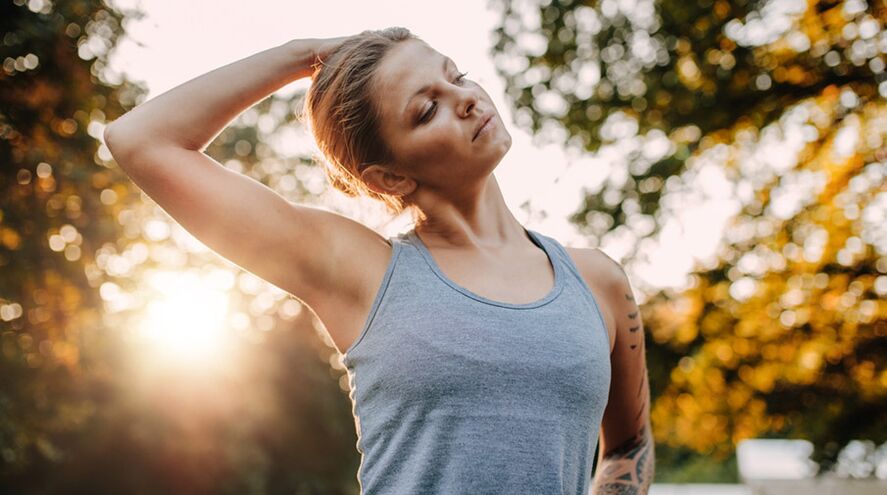To significantly improve the condition of a patient with cervical osteochondrosis, physiotherapy (PT) is often used. It helps eliminate many symptoms of this unpleasant disease.

How exactly do exercises help?
Regular exercise therapy for cervical osteochondrosis strengthens muscles, relieves muscle spasms, increases blood circulation and improves the condition of the intervertebral discs. If you choose the right exercises, you can eliminate the unpleasant sensations that often accompany cervical osteochondrosis. These include headaches, pain in the shoulders and arms, and dizziness.
It is not always possible to contact a specialist. In principle, it is not a problem to carry out physiotherapy on your own. These exercises can easily be done at home. There are simple sets of exercises that even beginners can do. One of these complexes is presented below.
What should we not forget when carrying out exercise therapy for cervical osteochondrosis? When performing exercises from the physiotherapy complex for cervical osteochondrosis, do not forget the following rules. This is important for your own safety. Exercises are only effective if done correctly. In addition, performing the exercises incorrectly can cause serious damage to the spine.
Contraindications to exercise therapy for osteochondrosis
- You cannot do exercises during the acute phase of osteochondrosis. It is unacceptable to perform them with pain.
- Perform the movements slowly, do not make sudden movements.
- Remember that with cervical osteochondrosis you cannot make circular movements with your head. Don't throw your head back either.
- Don't be seduced by the advertising of cervical traction devices. It is unsafe to use such devices without consulting a specialist. Simple carelessness can result in serious injury.
- If you have been diagnosed with an intervertebral hernia, it is unacceptable to perform these and other exercises without consulting a doctor!
An approximate complex of exercise therapy for cervical osteochondrosis in the non-acute stage
You should start with a warm-up. You can use regular walking in place as a warm-up exercise. It is effective to walk on the whole foot first and then on the toes and heels. In this case, the arms should be relaxed and hanging freely, the shoulders should be stretched and slightly lowered. The warm-up time is 2-3 minutes.
1. Exercise to relax the neck muscles
Stand up straight. Your arms should hang freely along your body. Clench your fists, tense your arms. At the same time, lower your shoulders and shoulder blades and straighten your back. Hold the tension for 30 seconds. Then relax and let your arms swing freely.
2. Tilt your head to the side
This exercise can be done both standing and sitting.
Gently tilt your head to the side (lower your ear toward your shoulder). Feel the neck muscles stretching. Hold this for 10-15 seconds. Then slowly return to your starting position and tilt your head to the other side. It is very important to perform this exercise as carefully as possible to avoid pain.
3. Turn your head to the side
This exercise can be done both standing and sitting.
Tilt your head down. Try to touch your chin to the cavity of your neck. Turn your head to the right as if sliding your chin over your breastbone. Stay in this position for 3 – 6 seconds. Then slowly turn in the other direction. Repeat this exercise 5-7 times in each direction.
4. Raise and lower your shoulders
You can do this exercise both standing and sitting.
Raise your shoulders as high as possible without moving them forward. Lower them and pull them back slightly as if you were straightening them. Repeat 6 – 8 times.
5. Move your shoulders forward and back
This exercise can be done both standing and sitting.
Starting position – shoulders stretched freely and lowered. We raise our shoulders and move them forward. Then you need to return to the starting position. Pull your shoulders back and try to close your shoulder blades. Return to the starting position. Repeat the exercise 6 – 8 times.
6. Tilt your head forward
This exercise can also be done standing or sitting.
Bend your neck forward and gently lower your chin to your chest. Then you have to sit up slowly. Repeat the exercise 6 – 8 times. Important: Keep your back straight!
7. Swing your arms back
We perform this exercise while standing or sitting.
Extend your arms to the sides, lower your shoulders. Press your shoulder blades toward your back. The outstretched straight arms move slightly backwards. Return to the starting position. Repeat the exercise 6-8 times. In this exercise you need to move your arms as little as possible and try to use only your back muscles.
8. Rotate the brushes
Arms at your sides, shoulders down. Bend your elbows, clench your hands into fists. Without lowering your elbows, make four circular wrist rotations in one direction and then four times in the other. Repeat the process 4 – 6 times in each direction.
9. Rotate your elbows
The starting position is the same as in the previous two. Make 4 circular rotations in the elbow joint in one direction and the other. There is no need to lower your elbows. Repeat the process 4 – 6 times in each direction.
10. Rotate your shoulders
Extend your arms to the sides, lower your shoulders. Perform 4 rotations in the shoulder joint in each direction. Repeat 4 to 6 times.
11. Raise and lower hands
Relax your shoulders and arms. We raise our hands and then let them fall freely. Breathing should be free and relaxed. Repeat 4 – 6 times.

















































